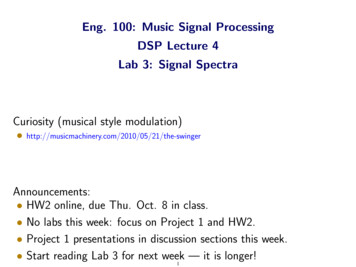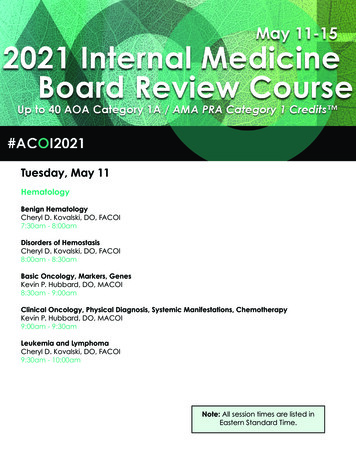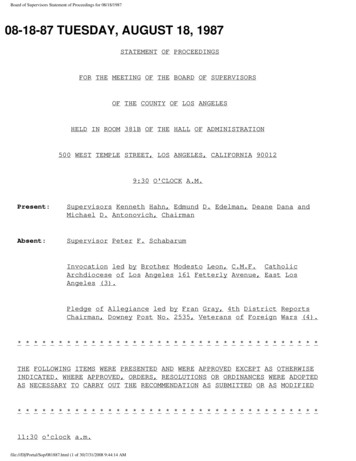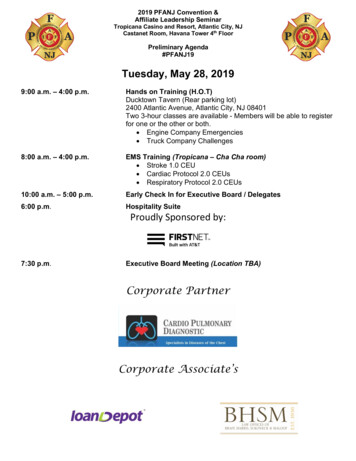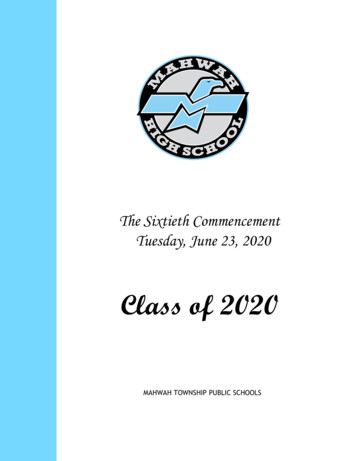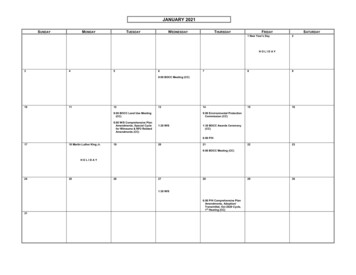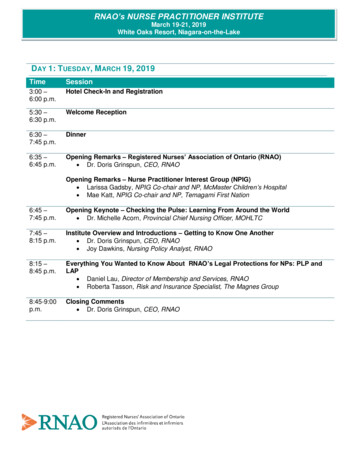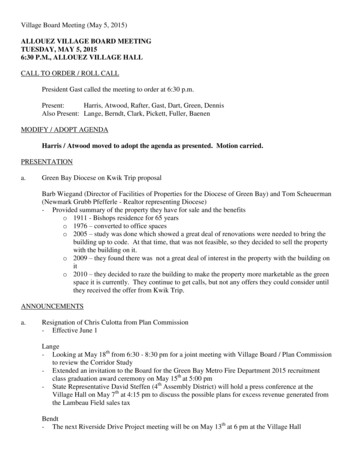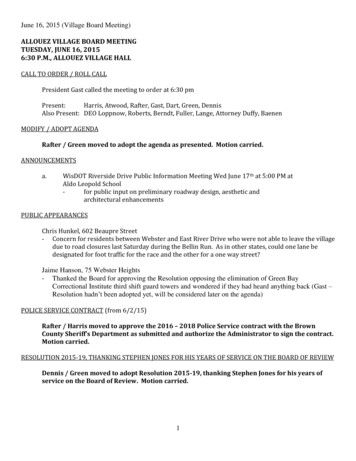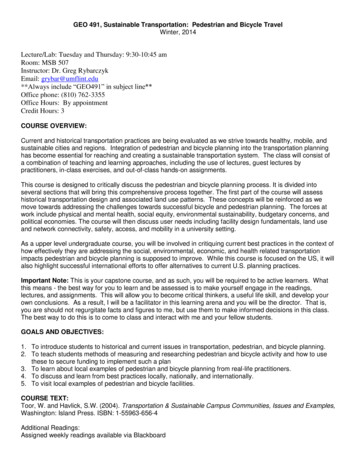
Transcription
GEO 491, Sustainable Transportation: Pedestrian and Bicycle TravelWinter, 2014Lecture/Lab: Tuesday and Thursday: 9:30-10:45 amRoom: MSB 507Instructor: Dr. Greg RybarczykEmail: grybar@umflint.edu**Always include “GEO491” in subject line**Office phone: (810) 762-3355Office Hours: By appointmentCredit Hours: 3COURSE OVERVIEW:Current and historical transportation practices are being evaluated as we strive towards healthy, mobile, andsustainable cities and regions. Integration of pedestrian and bicycle planning into the transportation planninghas become essential for reaching and creating a sustainable transportation system. The class will consist ofa combination of teaching and learning approaches, including the use of lectures, guest lectures bypractitioners, in-class exercises, and out-of-class hands-on assignments.This course is designed to critically discuss the pedestrian and bicycle planning process. It is divided intoseveral sections that will bring this comprehensive process together. The first part of the course will assesshistorical transportation design and associated land use patterns. These concepts will be reinforced as wemove towards addressing the challenges towards successful bicycle and pedestrian planning. The forces atwork include physical and mental health, social equity, environmental sustainability, budgetary concerns, andpolitical economies. The course will then discuss user needs including facility design fundamentals, land useand network connectivity, safety, access, and mobility in a university setting.As a upper level undergraduate course, you will be involved in critiquing current best practices in the context ofhow effectively they are addressing the social, environmental, economic, and health related transportationimpacts pedestrian and bicycle planning is supposed to improve. While this course is focused on the US, it willalso highlight successful international efforts to offer alternatives to current U.S. planning practices.Important Note: This is your capstone course, and as such, you will be required to be active learners. Whatthis means - the best way for you to learn and be assessed is to make yourself engage in the readings,lectures, and assignments. This will allow you to become critical thinkers, a useful life skill, and develop yourown conclusions. As a result, I will be a facilitator in this learning arena and you will be the director. That is,you are should not regurgitate facts and figures to me, but use them to make informed decisions in this class.The best way to do this is to come to class and interact with me and your fellow students.GOALS AND OBJECTIVES:1. To introduce students to historical and current issues in transportation, pedestrian, and bicycle planning.2. To teach students methods of measuring and researching pedestrian and bicycle activity and how to usethese to secure funding to implement such a plan3. To learn about local examples of pedestrian and bicycle planning from real-life practitioners.4. To discuss and learn from best practices locally, nationally, and internationally.5. To visit local examples of pedestrian and bicycle facilities.COURSE TEXT:Toor, W. and Havlick, S.W. (2004). Transportation & Sustainable Campus Communities, Issues and Examples,Washington: Island Press. ISBN: 1-55963-656-4Additional Readings:Assigned weekly readings available via Blackboard
GRADING CRITERIA AND ComprehensionStudent panel discussion ofof subject areaassigned group topicalreadings andreadingsconceptsActive Learning StrategyLearn the majorcomponents ofa bike/ped planMeasurementStrategiesGraded 6 pagereportWritten report willillustrate level ofcritical thinkingand analysis of aplanningdocument2 page writtensummary of thegoals andoutcomes from themeeting2502/25Critique a university Bicycleand Pedestrian Master Plan3503/25Memo summarizing publicpedestrian or bicyclemeetingUnderstand theimportance ofpublic inputWalking AuditLearn acommontransportationfield datacollectionmethodWritten report(with maps andpics) will illustratequality of walkingamenitiesBicycling AuditLearn acommontransportationfield datacollectionmethodBicycle field datacollection report(including mapsand /84/17652n/a7100 (Presentation- 50 Paper – 50)4/23TotalIncreasedassimilation ofcourse topicsGroup final paper on theIn-depthtopic of your choice, building comprehensionon previous assignments or of a bicycle orconcepts covered in thepedestriancourse (individual)related topicClass Participation/GuestSpeaker EvaluationParticipationPointsFinal Whitepaper/presentationgrade400CLASS PARTICIPATION:This class relies on active participation from students. You will be graded on class participation during guestlectures and during each class meeting. You will be assessed based on your attendance and participationduring these events. One point will be given for attendance and 1 point will be given for participation.Reading the assigned readings before class will ensure your class participation. You will not receive anypoints if the following are witnessed: computer activity, texting, talking out of turn, using your cellphone, arriving to class late, etc. You will receive points for: active engagement during class, aka,asking questions and attentive behavior.
CLASS ASSIGNMENTS:The five assignments are designed to provide you practical experience with elements needed to properlyassess bicycle and pedestrian environments. Detailed assignment tasks will be discussed in class, but willinvolve literature reviews, attendance at public meetings, presentation skills, field data collection methods,evaluation of current bicycling and pedestrian levels, and review of bicycle and pedestrian master plans. Someassignments will involve group work.WHITE PAPER:A final paper on a bicycle or pedestrian related topic is required. The intended audience is practicing planners,engineers, and/or advocates working in the U.S. The objective is to provide an overview of the state ofresearch on a certain topic, draw conclusions that are useful to practitioners, and indicate needs for futureresearch or changes in practice. The paper should be 10-12 pages, double-spaced. You should be usingacademic, peer-reviewed literature (5 minimum), complemented with public agency reports and other media.You may summarize pervious assignment results.POLICIES:Assignments are due in class or via Blackboard as noted in the syllabus. I will accept late assignments but Iimmediately take off 10% of the grade for each day that it is late in addition to points taken off from errors.Assignments more than a week late will receive a 50% reduction. Assignments handed in greater than twoweeks past the deadline will not be accepted.Plagiarism or any other form of academic misconduct (such as misbehaving in the classroom, disrupting thelearning process of other students, and disrupting the teacher) will not be tolerated. Please refer to page 38 ofthe current UM-Flint catalog for an overview of the University’s plagiarism policy. For questions or concernsregarding course work and your performance, I encourage you to make an appointment with me to discussthis.
SubjectWeek1 (1/9)ClassTopicReadingAssign.1History of Non-MotorizedTransportation in the ty on CollegeCampusesCh. 1 and 2Assignment#13Campus TransitSustainability (GuestSpeaker: Jennifer Skutt,MTA TransportationPlanner)Ch. 4GuestSpeakerEvaluation4Measuring the Benefits ofNon-MotorizedTransportationHandoutNone5Land Use, ConnectivityHandoutNone6Bicycling and SocietyHandoutFurnessNone7Student PresentationsNoneAssignment1 Due8Statewide Bicycle Planning(Guest Speaker: JoshDeBruyn, Bicycle andPedestrian sign 29Pedestrian and BicycleFacility PlanningFundamentals, the 5 E’sCh. 5None10Pedestrian and BicycleSafety: Crash AnalysisBlackboardReadingNone11Trail Planning in Flint(Guest Speaker: JackMinore - Friends of theFlint River Trail, FlintRiver WatershedCoalition)*BlackboardReading (TCtrail)GuestSpeakerEvaluation12Bicycle DesignBlackboardNone2 (1/14,1/16)Nonmotorizedtransportation Issues3 (1/21,1/23)4 1/28,1/30)5 (2/4,2/6)BicycleandPedestrianPlanningBasics6 (2/11,2/13)7 (2/18,2/20)
8 (2/25)8 ingSolutions14Public Participation,Coalition Building, andPartner Buy-inBlackboardAssignment2 DUE15Education andEncouragement (GuestSpeaker: Ali Harris, CrimFitness Foundation)*HandoutGuestSpeakerEvaluation9 (3/4,3/6)Spring Break, No Class10(3/11)16UM-Flint Bicycle Safety(Guest Speaker: RussellUM-Flint Dept. of Safety)NoneGuestSpeakerEvaluation10(3/13)17Data Collection Needs,Sources, Methods, andMeasuresHandoutNone18Field Trip: Grand TraverseGreenway Public meeting*BlackboardNone19Travel Demand EstimationBlackboardNone11(3/18,3/20)20Field Work: Walking Audit*HandoutAssign #3DUE.Assignment#421Transportation GISBlackboardNone13 (4/1)22Field Work: Bicycle Audit*Hand-outAssignment#513 (4/3)23Transportation SystemsInternational ApproachesCh. 7,Frank/BBAssignment#4 DUE24Bike SharingBlackboard,City CyclingCh. 912(3/25,3/27)14 (4/8,4/10)No Class – Work on Assignment #515(4/15,4/17,2526Bicycle Technology(Guest Speaker: Dr.Farmer, Eng. Dept.)Blackboard Ch.5 City CyclingStudent PresentationsFinal White Paper Due April 23rd, 5:00 pm*Class contents can be changed according to the instructor during the semesterAssignment#5, DUE
Email: grybar@umflint.edu **Always include “GEO491” in subject line** Office phone: (810) 762-3355 Office Hours: By appointment Credit Hours: 3 COURSE OVERVIEW: Current and historical transportation practices are being evaluated as we strive towards healthy, mobile, and sustainable cities and regions. Integration of pedestrian and bicycle planning into the transportation planning has .


